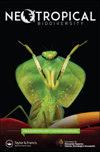Germination of high Andean treeline species of contrasting environments and along elevational gradients in northwest Argentina
IF 0.8
Q4 ECOLOGY
引用次数: 3
Abstract
ABSTRACT In mountain ecosystems, temperature and precipitation change along elevation and determine the lower and upper limits of tree species which form forests. Early life performance of tree species has been assessed along elevational gradients as a proxy for several environmental variables. Here, we attempt to answer the following question: How does elevation provenance influence seed mass, viability, and germination of Queñoa (Polylepis spp.)? We worked with four species from two contrasting environments from northwest Argentina. We gathered seeds along elevation gradients, seeds were weighed, tested for viability (Triphenyltetrazoliumchlorid; TTC) and germination percentage in a controlled environment. The analysis was performed using Generalized Linear Models (GLM). We found low germination percentages in all species, probably related to low seed viability. The two species from humid environments had lower seed mass and higher germination percentages than the two species from dry environments. The effect of elevational provenance negatively affected the germination of two species, while the other two species were not affected. We conclude that although the four species studied belong to the same genus, their early life characteristics differ between environments and along elevational gradients according to species. Trends regarding future temperatures suggest increases in germination for two of our study species and no effects on the other two species.阿根廷西北部不同环境和海拔梯度的安第斯高树线物种的发芽
摘要在山地生态系统中,温度和降水量随着海拔高度的变化而变化,并决定了形成森林的树种的下限和上限。已经沿着海拔梯度评估了树种的早期生活表现,作为几个环境变量的代表。在这里,我们试图回答以下问题:海拔种源如何影响Queñoa(Polylepis spp.)的种子质量、活力和发芽?我们研究了来自阿根廷西北部两个截然不同环境的四个物种。我们沿着海拔梯度收集种子,对种子进行称重,在受控环境中测试活力(三苯基四唑啉;TTC)和发芽率。使用广义线性模型(GLM)进行分析。我们发现所有物种的发芽率都很低,这可能与种子活力低有关。湿润环境中的两个种的种子质量较低,发芽率较高。海拔种源的影响对两个种的发芽产生了负面影响,而其他两个种则没有受到影响。我们得出的结论是,尽管所研究的四个物种属于同一属,但它们的早期生活特征在不同环境和不同物种的海拔梯度上有所不同。关于未来温度的趋势表明,我们研究的两个物种的发芽率增加,对其他两个物种没有影响。
本文章由计算机程序翻译,如有差异,请以英文原文为准。
求助全文
约1分钟内获得全文
求助全文
来源期刊

Neotropical Biodiversity
Environmental Science-Ecology
CiteScore
1.80
自引率
0.00%
发文量
39
审稿时长
24 weeks
 求助内容:
求助内容: 应助结果提醒方式:
应助结果提醒方式:


